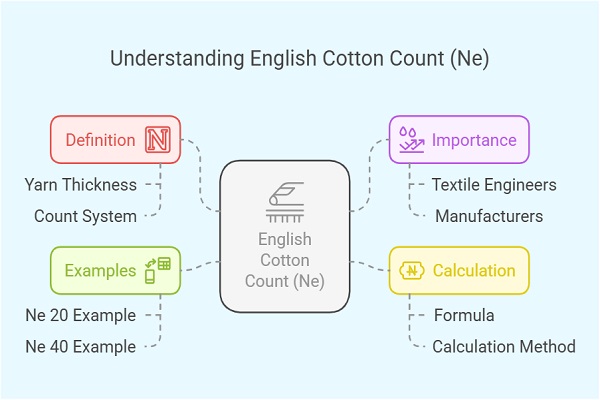English Cotton Count (Ne) Calculator
© Yarn Count Ltd. All rights reserved.
Disclaimer: All tools in the Yarn Count have been reviewed by the relevant spinning industry experts.
The formula for calculating the English Cotton Count (Ne)
Ne = L ÷ W
Where:
- L = Length of the yarn in yards (840 yards in one hank).
- W = Weight of the yarn in pounds.
Table of Contents
What is English Cotton Count (Ne)?

English Cotton Count (Ne) is a standard measurement used in the textile industry to determine the thickness of yarn. This count system is important for textile engineers and manufacturers because it helps define the fineness or coarseness of cotton yarns. Understanding Ne is essential for selecting the right type of yarn for different fabric types and applications. The number assigned to cotton yarn indicates how many hanks of yarn, each 840 yards long, weigh one pound.
The English Cotton Count system plays a vital role in ensuring that the right yarn is used for producing fabrics with the desired texture, strength, and appearance. The English Cotton Count (Ne) measures the number of 840-yard lengths of yarn that weigh one pound. It provides a way to quantify the thickness or fineness of the yarn. The higher the count number, the finer the yarn; conversely, the lower the count, the coarser the yarn.
For example:
- A yarn with a count of Ne 20 means that 1 pound of the yarn consists of 20 hanks, with each hank being 840 yards long.
- A yarn with a count of Ne 40 would mean that 1 pound of yarn consists of 40 hanks, making it finer than Ne 20.
This counting system helps textile engineers, designers, and manufacturers to choose yarns that are appropriate for the fabric they want to create, whether it’s for fine, lightweight garments or heavier, durable fabrics.
How to Calculate English Cotton Count (Ne)
The formula for calculating the English Cotton Count (Ne) is straightforward. It is based on the weight and length of the yarn. The calculation involves dividing the number of yards per pound by 840 yards. Here’s the formula:
Ne = Number of yards in 1 lb ÷ 840
For example, if you have a yarn that is 4,200 yards long and weighs one pound, the calculation would be:
Ne = 4200 ÷ 840 = 5
Thus, the yarn would have an English Cotton Count of Ne 5. This means that 1 pound of this yarn consists of 5 hanks of 840 yards each.
Practical Example
If you’re working with a cotton yarn that has 6,720 yards in one pound, the Ne calculation would be:
Ne = 6720 ÷ 840 = 8
So, the yarn would have a count of Ne 8. This would be finer than a Ne 5 yarn but coarser than a Ne 10 yarn.
Why is English Cotton Count Important?

The English Cotton Count system provides several advantages in textile manufacturing:
1. Yarn Selection
Knowing the Ne value helps textile engineers choose the right yarn for specific fabric requirements. For instance, finer yarns (higher Ne values) are used in fabrics that need to be smooth and delicate, like those for shirts or sheets. Coarser yarns (lower Ne values) are ideal for more durable fabrics, such as denim or canvas.
2. Standardization
The Ne system is an international standard for cotton yarn measurement. It provides a universal method for comparing yarns across different manufacturers and regions. This standardization ensures consistency in production and quality control.
3. Cost Efficiency
By understanding the Ne value, textile manufacturers can manage costs more effectively. Fine yarns typically cost more because they require more processing and are more delicate to handle. Understanding the yarn count helps manufacturers avoid wastage and select the best materials for their production needs.
4. Fabric Properties
The English Cotton Count also influences the final fabric properties, such as texture, drape, and strength. Finer yarns contribute to softer, smoother fabrics, while coarser yarns result in stronger, more durable fabrics.
How to Use the English Cotton Count in Manufacturing
In the textile industry, the use of English Cotton Count extends beyond just measuring yarn thickness. It is a key factor in designing the production process for a specific fabric. Here’s how it applies:
1. Weaving and Knitting
The Ne count helps in determining how many threads or yarns should be used in weaving or knitting to achieve the desired fabric properties. For example, finer yarns may require more threads per inch to create a dense fabric, while coarser yarns may need fewer threads to achieve the same result.
2. Fabric Design and Texture
Yarn count impacts the texture of the fabric. Designers use Ne to select yarns that will give fabrics their intended feel. High Ne yarns produce softer fabrics, while lower Ne yarns result in thicker and stronger materials.
3. Dyeing and Finishing
Yarn count also affects dyeing and finishing processes. Finer yarns tend to absorb dyes more evenly, producing smoother finishes, while thicker yarns may require different treatments to achieve uniform color and texture.
Conclusion
The English Cotton Count (Ne) system is a vital measurement in textile manufacturing, helping to ensure that the right yarn is chosen for each fabric’s intended use. It is crucial for textile engineers to understand how Ne impacts the final product, from fabric strength and texture to cost and efficiency. By mastering the use of Ne, textile professionals can create high-quality, well-suited fabrics for a variety of applications.
Whether you are working with fine cotton fabrics for clothing or heavier materials for industrial uses, understanding and calculating the English Cotton Count is essential for achieving the best results in textile manufacturing.